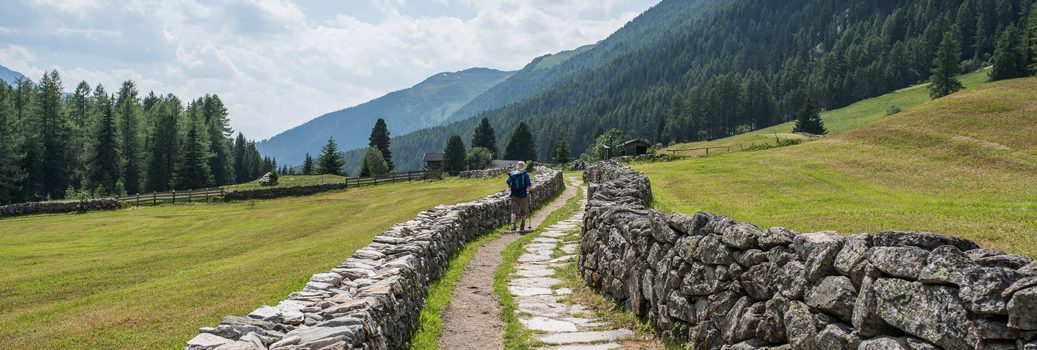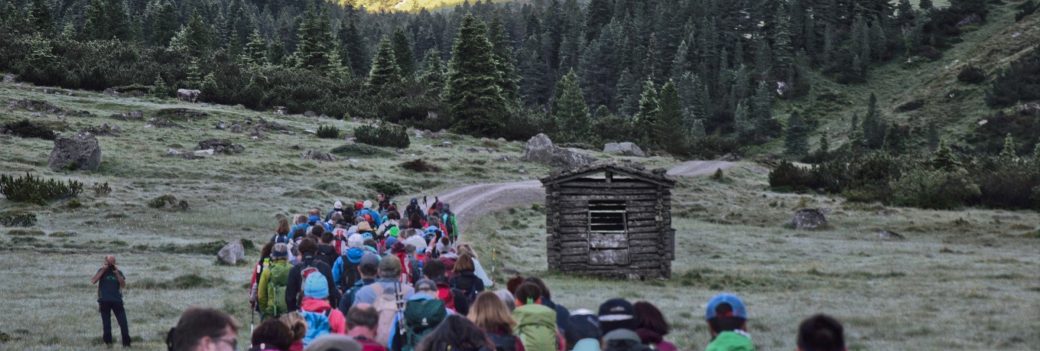The filming of the July 1963 Nazi trial of Franz Murer, the former head of staff of the Vilnius City Area Commissioner, brought this case to wider public attention in 2018. This trial is considered a paradigmatic example of the inadequate judicial punishment of Nazi criminals by jury courts in Austria, mainly because of the dubious acquittal and the openly revealed anti-Semitism.
A contribution by Lukas Nievoll
Franz Murer’s career
Franz Murer was born in 1912 and grew up in a rural Catholic environment in Murtal (Styria). After his school career, he earned his money on farms and estates in Styria and Burgenland. In May 1938, Franz Murer eventually joined the NSDAP, presumably to give his career a boost. Thus, he sought a place at one of three “Ordensburgen,” where, according to Nazi propaganda, future party leadership personnel were to be trained and educated physically, character-wise, and ideologically. Murer attended the “Ordensburg” Krössinsee in present-day Poland from December 1938 to July 1940. After participating in the German campaign against France as a Wehrmacht soldier from July 1940, he was detached to “the East” to Lithuania like other “Ordensjunker”. The 29-year-old Styrian arrived in August 1941 in the capital Vilnius, which, as a center of Jewish culture, was also called the “Jerusalem of the East.” Before the German invasion of Vilnius in June 1941, around 55,000 Jews (30% of the population) lived there. By the end of 1941 alone, about 40,000 Jews had been executed at the Ponary execution site. Officially, Murer was chief of staff to the Vilnius City Area Commissioner, Hans Hingst, acting as his deputy and adjutant. In this role, he was centrally involved in the establishment of two Jewish “ghettos” to which Jews of all ages were forcibly relocated. After only a few weeks, in October 1941, the Jews of the small “ghetto” in Ponary who were “not fit for work” from the National Socialist point of view were shot.
Return home and first trial
Franz Murer was transferred from Vilnius in the summer of 1943. After a few short stops in between, he was assigned to Parachute Artillery Regiment No. 4 in Italy. As part of this regiment, Franz Murer was captured by British troops at the end of the war and eventually returned to the Murtal valley in Gaishorn at the end of 1945. After working there for some time with his wife and children on the farm, he was arrested in June 1947, presumably on the basis of testimonies by Jewish DPs. In the course of the investigation, Franz Murer was handed over to the Soviet authorities in 1948, who subsequently brought him to Vilnius. On September 29, 1948, a Soviet military court sentenced Franz Murer to the maximum sentence of 25 years in a labor camp. It highlighted his central role in the murder and persecution of “Soviet citizens of Jewish nationality,” in the establishment of the “ghetto,” and in shootings carried out and ordered by him personally. However, Murer was repatriated as early as 1955 under the State Treaty along with other prisoners of war imprisoned as war criminals. As a result, the responsible public prosecutor’s office in Austria failed to initiate criminal proceedings against the convicted war criminal, which was actually required by law. It was argued that he had already served a large part of his prison sentence, although Murer had not even served one third of his original sentence. It was not until a few years later that Simon Wiesenthal set the ball rolling for Murer’s prosecution in Austria. Probably also because of the internationally acclaimed trial of Adolf Eichmann in Israel, which was already underway at that time, international pressure on Austria to deal with Nazi war criminals increased. Thus, after two years of investigation, Franz Murer was brought to trial before a jury in Graz on June 10, 1963.
The trial against Franz Murer
After the Nazi Amnesty Act was passed in March 1957 and the so-called War Crimes Act (KVG) was repealed with it, complex Nazi crimes of mass violence could only be prosecuted in jury trials according to the provisions of the traditional penal code. These changes in connection with the absence of a renewal of the law can definitely be seen as symptomatic of an unwillingness on the part of Austrian politics to deal with Nazi crimes after regaining independence. In this respect, Franz Murer was “only” charged with 15 counts, in most cases murder. The Neue Zeit reporter therefore considered it the “surprise of the trial” that Murer was “not called to account for the extermination of the Jews,” “but only for fifteen counts of murder.”
Holocaust survivors as witnesses in the trial
The trial was a special challenge for the Holocaust survivors, most of whom traveled to Graz from Israel. For the majority of them it was the first time they had ever had to testify in court. The witnesses had different motives for testifying in court. Moshe Feigenberg, who had worked as a doctor in the “ghetto hospital” in Vilnius, spoke about wanting to testify on behalf of the victims: “We do not come from the Holy Land – from Israel – whose capital is Jerusalem, to take revenge, but because of the victims of the city of Vilnius, which we call the Jerusalem of Lithuania. Another witness, Jacob Kagan, was more concerned with Murer’s criminal prosecution, as he mentioned during the trial that he was concerned with justice for his father. In his testimony, he described how Murer had shot him in front of his eyes at the entrance to the “ghetto” because he wanted to bring food to the “ghetto.” The Holocaust survivor’s testimony in the face of Murer was also an extremely great psychological and physical strain. According to newspaper reports, when Sima Kinbrenner told of how Murer had shot a woman because she wanted to buy bread, she became so agitated that it was difficult to calm her down.
Anti-Semitism at the trial
Added to these already difficult circumstances were anti-Semitic social currents that emerged openly during and around the trial. In these narratives, there was talk of a [Jewish] smear campaign against Murer. For example, this phrase can be found verbatim on a signature list submitted by the defense before the trial, which was largely signed by farmers from Upper Styria. In this account, Murer, a righteous farmer and ÖVP local politician, was the victim. Most relevant to the trial, however, were the anti-Semitic arguments of Murer’s defense lawyer Karl Böck. These were opinion-forming in view of the verdict and fell on fertile ground with the jury. He, too, repeated Murer’s victim role and stated that he was only accused of the deeds by “Jews” because he had worn a German uniform, not because he had actually committed the deeds. Furthermore, he presented inconsistencies in the witness statements in an exaggerated and sweeping manner and generally spoke of “lying witnesses. In addition, Murer’s defense counsel spoke several times of a certain steering and direction of the Holocaust survivors, and that “Jewish authorities” would repeatedly send accusations to the Austrian Ministry of Justice. These remarks clearly show how defense counsel Böck framed the testimony of Holocaust survivors largely in anti-Semitic terms as “Jewish testimony.” This, according to Murer’s defense counsel, was characterized by organization, lies, and thoughts of revenge. In this account, Murer would not have been accused because he had actually committed the murders, but rather “the Jews” had merely taken Franz Murer as a symbolic scapegoat.
An “Austrian verdict” or a “verdict against Austria”?
The statements of the defense attorney became decisive for the discourse at the trial, and after only seven days of proceedings Franz Murer was acquitted of all charges. The transcript of the verdict shows that the witnesses were simply not believed. Only in the case of Abraham Isak Kagan, whom Murer had shot with a pistol at close range according to the testimony of his son, did some jurors believe the descriptions of the witness. However, according to the verdict transcript, they could not see any intent to kill on Murer’s part. According to newspaper reports, when the verdict was announced, spectators in the courtroom applauded. In most daily newspapers, however, especially from the social democratic spectrum, the acquittal was seen as a scandal. The Volksstimme wrote: “Murer’s acquittal is a judgment against Austria” and spoke of a “blatant miscarriage of justice”. In its report on the trial, Die Wahrheit also immediately offered an explanation of how such a verdict could come about: “The verdict was made possible primarily by the [conservative] milieu from which Murer found his support […].” Something similar was mentioned by Eytan Otto Liff, the senior officer for Nazi violent crimes at the Israel Police National Staff. He wrote of the “bankruptcy of the Austrian judiciary” and pleaded for a transfer of future trials “from the provinces and their ‘friendly’ personal relations and milieu of opinion to Vienna” to the international public.
The outcome of the jury trial against Franz Murer in Graz represented the bankruptcy of Austrian justice. – Eytan Otto Liff
The Murer case can thus be seen as a paradigmatic example of the inadequate judicial punishment of Nazi criminals by jury courts in Austria. Despite sufficient evidence, the jurors could not bring themselves to reach a verdict. This can be explained mainly by the discourse-determining anti-Semitic argumentation of the defense counsel at the trial, which fell on fertile ground with the jurors. Moreover, Franz Murer, as a regional ÖVP functionary, was supported by parts of the population and the conservative camp, where anti-Semitic explanations were also used. The Holocaust survivors who had come to Graz to report on the atrocities committed by Murer in Vilnius were brought before the court. Their testimonies as persecuted Jews did not fit the victim narratives prevalent in Austria at the time. In these, National Socialists and war criminals such as Franz Murer were portrayed as supposed victims of Soviet persecution and “Jewish agitation”. In the end, the acquittal was also due to gross negligence on the part of the Austrian judiciary and an inconspicuous prosecutor in the trial, who did not succeed in questioning Murer’s not very original and repetitive defense strategies.
Information on the author: Lukas Nievoll is a research associate at the Center for Jewish Studies in Graz.
Further reading:
Lukas Nievoll, “Jüdische” Zeugenschaft – Aspekte des Umgangs mit Holocaust-Überlebenden am Beispiel des Prozesses gegen Franz Murer 1963 in Graz. In: Gerald Lamprecht, Heidemarie Uhl, Nachkriegserfahrungen. Exklusion und Inklusion von Opfer-Täter-Kollektiven nach 1945, zeitgeschichte, 48. jg., Heft 2 (Wien 2021) 207-224. – Here are also the exact source references, for the quotations mentioned in the text.
Johannes Sachslehner, “Roses for the Murderer. The two lives of the Nazi perpetrator Franz Murer.
Vienna-Graz-Klagenfurt 2017. – The most detailed biography of Franz Murer’s life to date.
Abraham Sutzkever, Wilner Getto. 1941-1944.
Abraham Sutzkever kept a diary about life in the “ghetto” of Vilnius established by the National Socialists.








